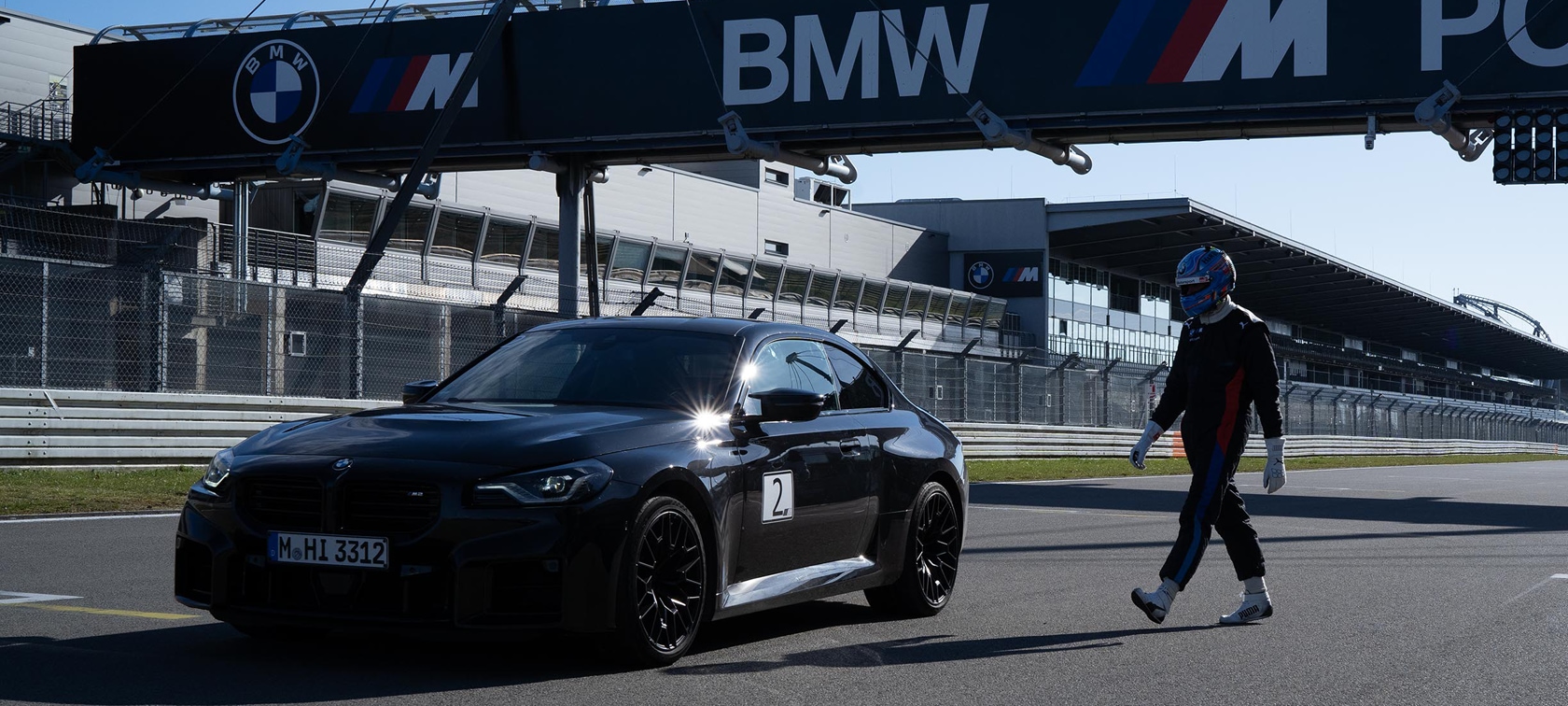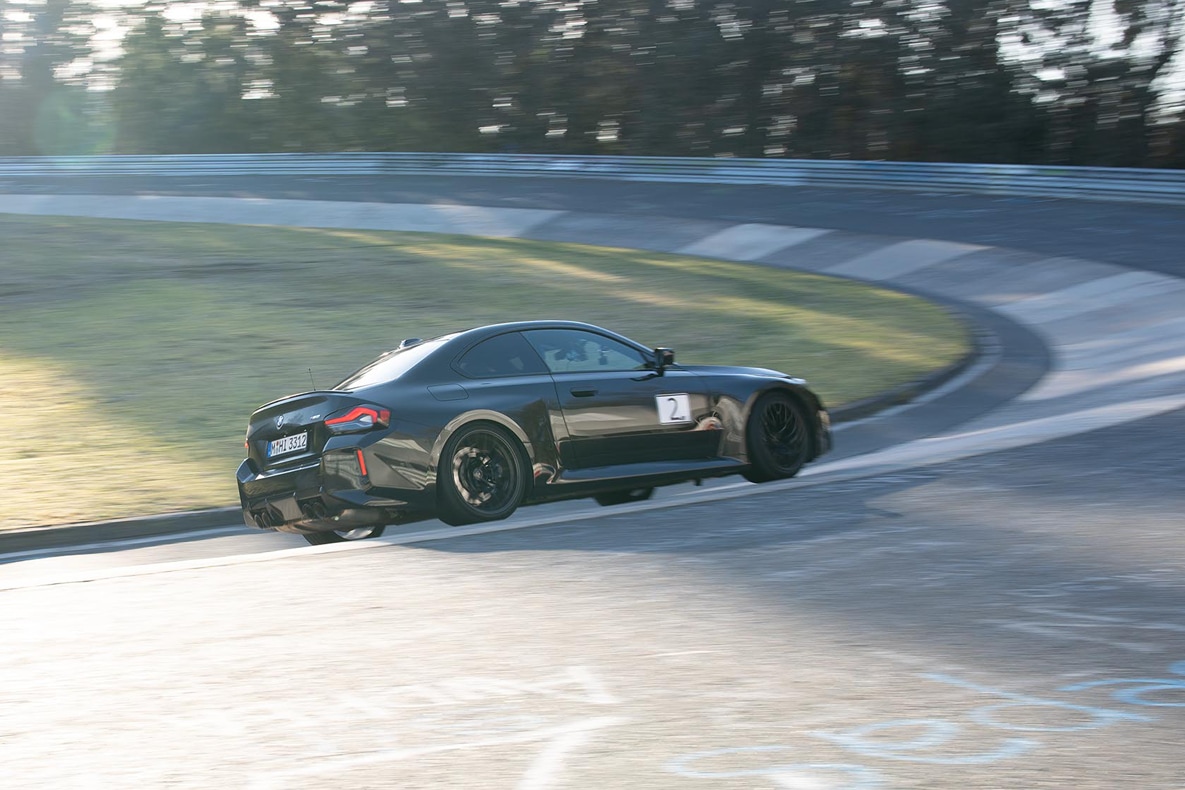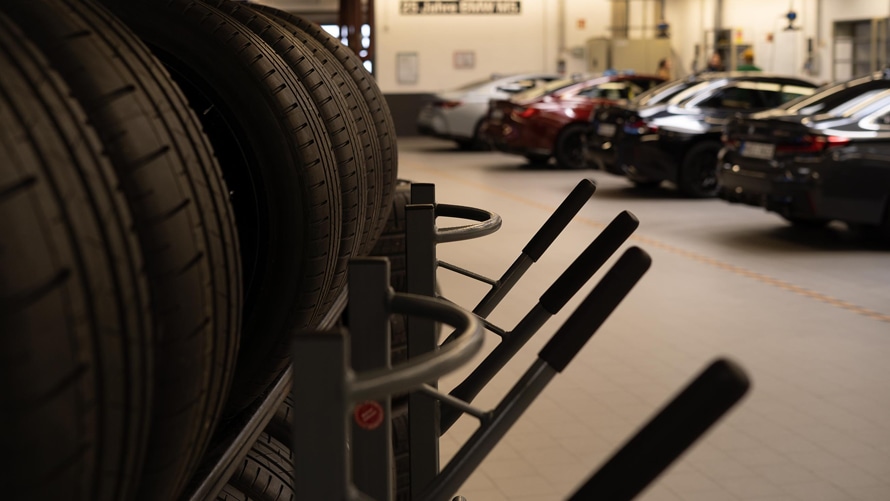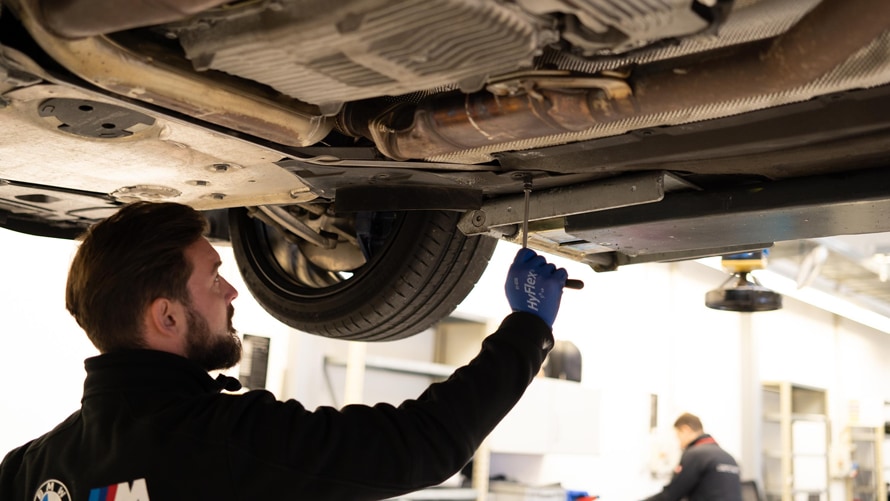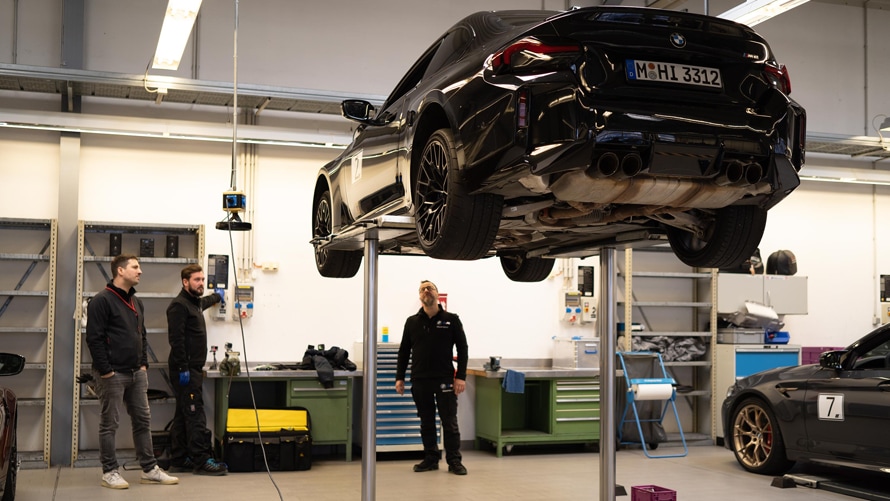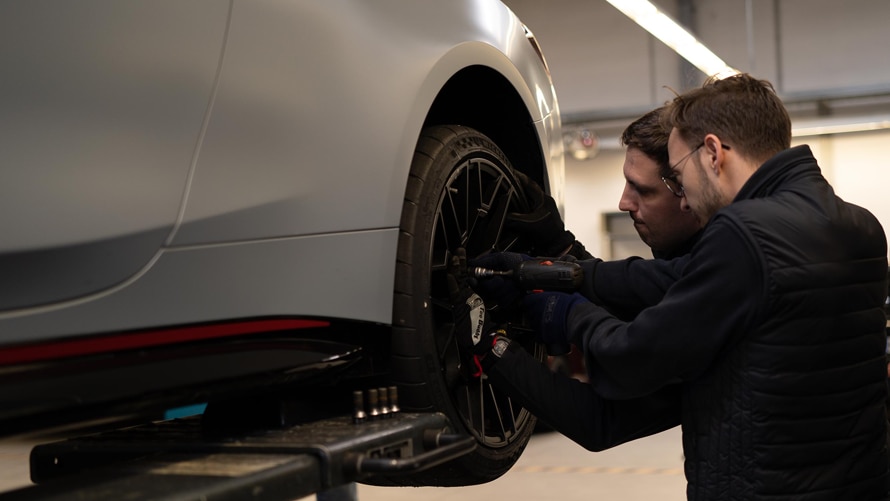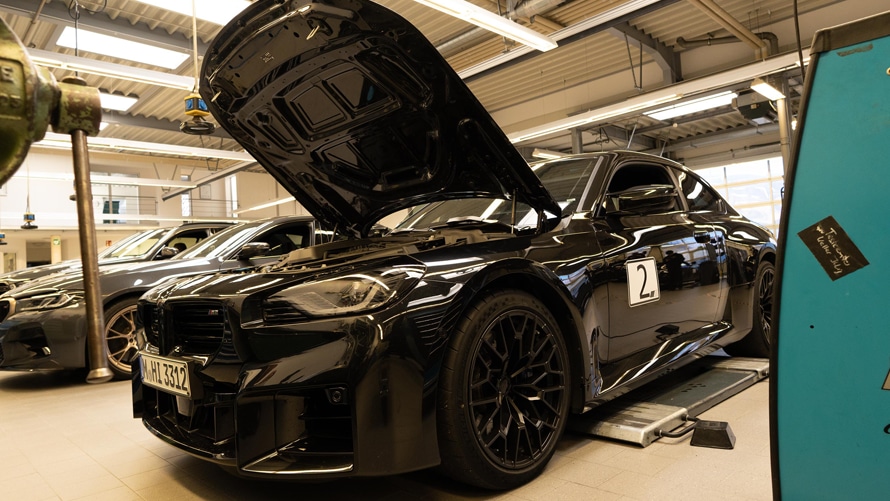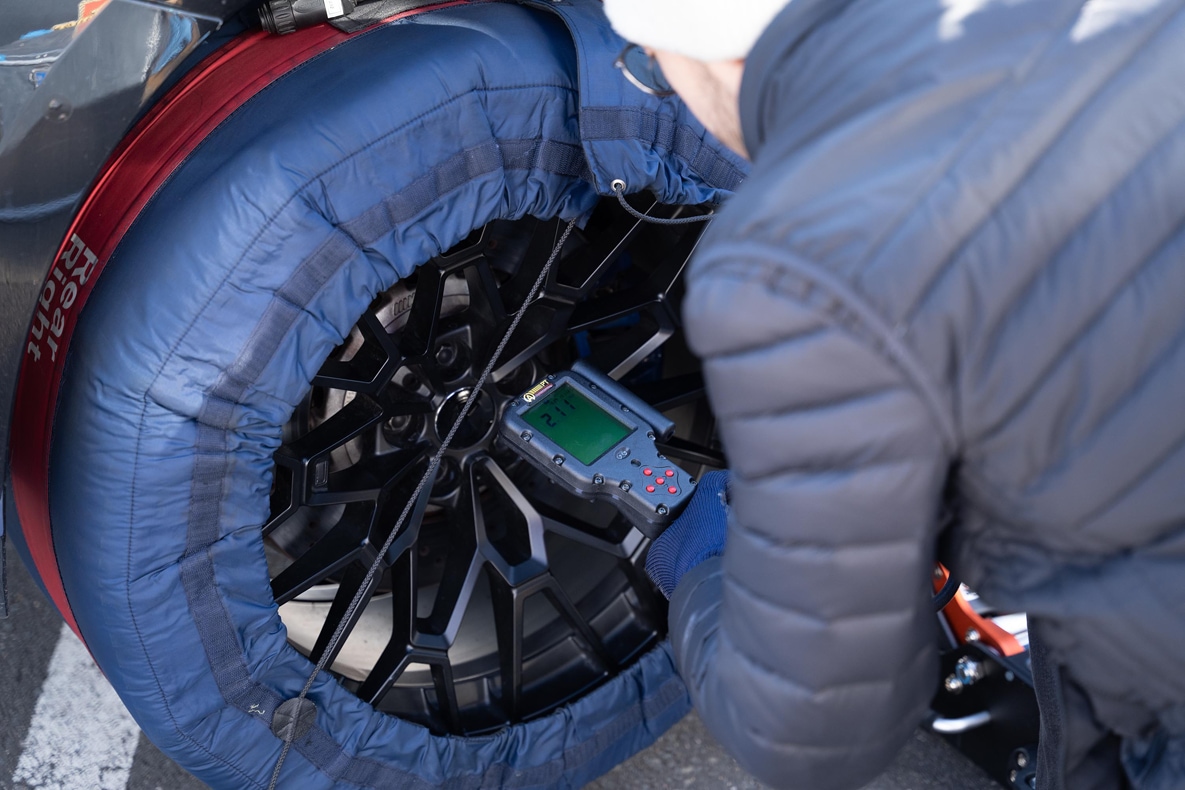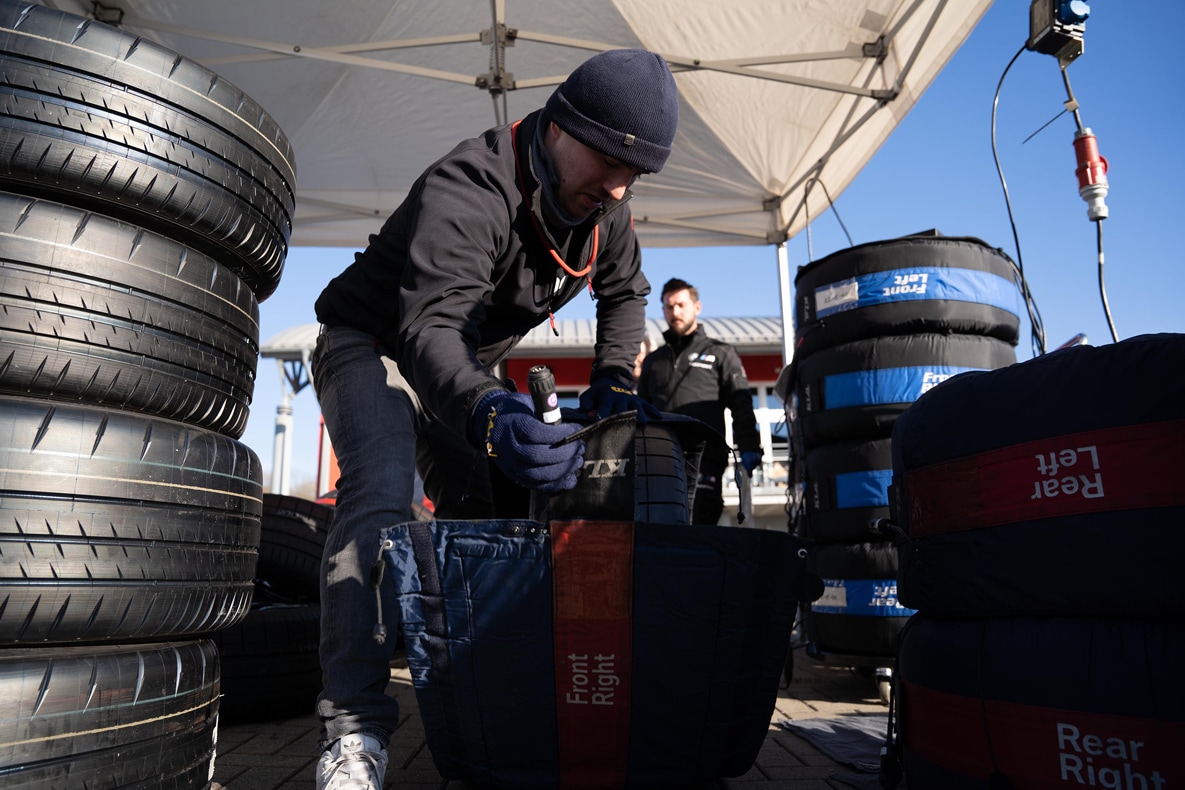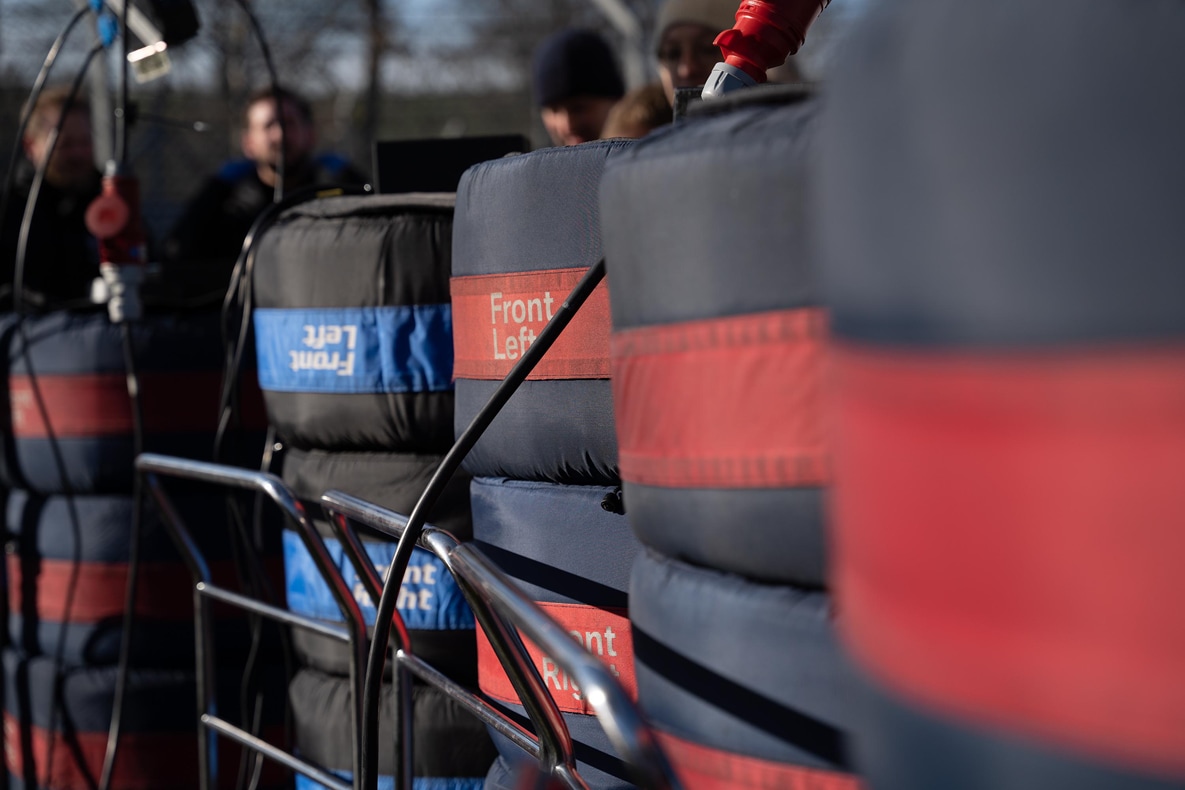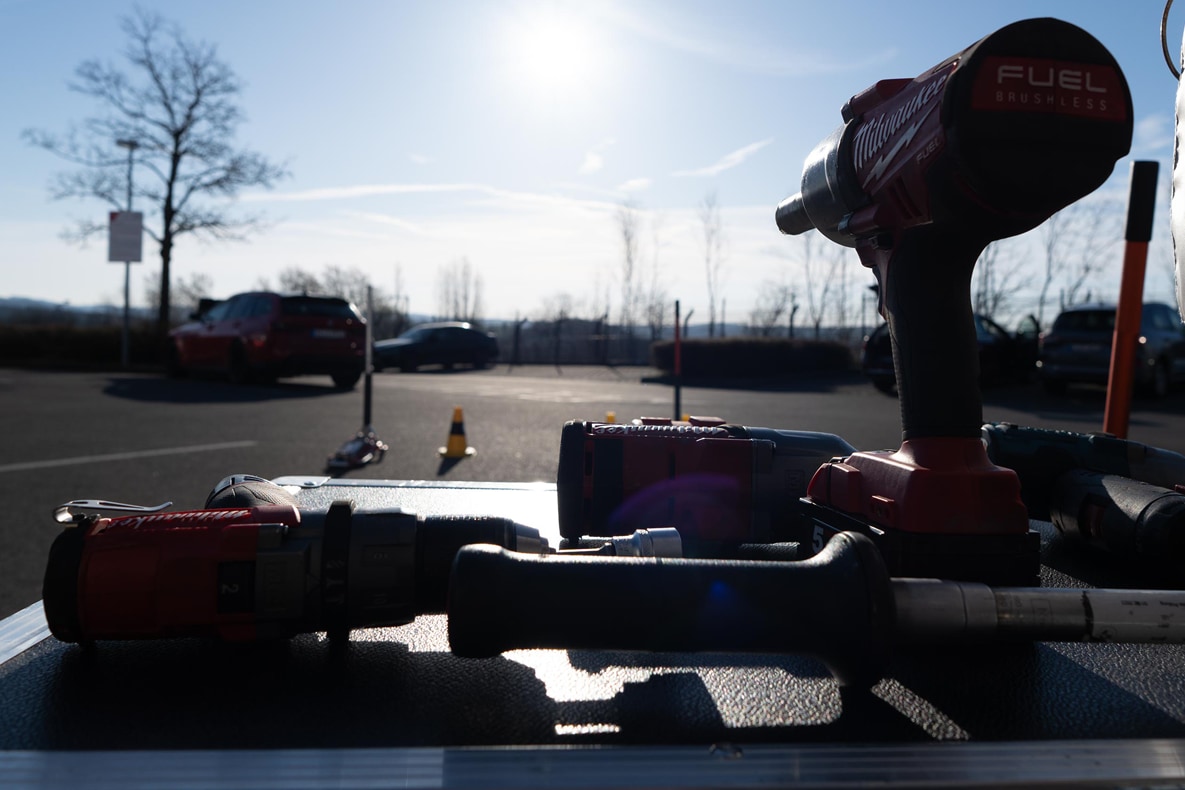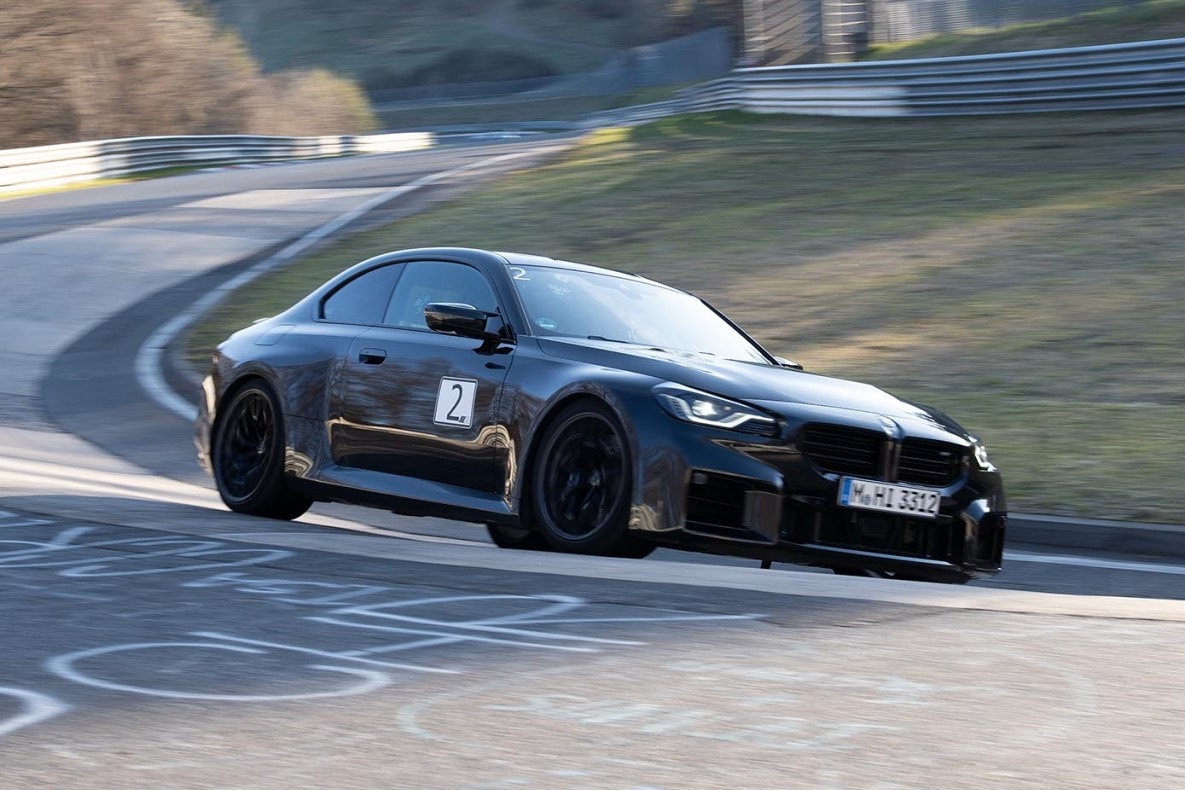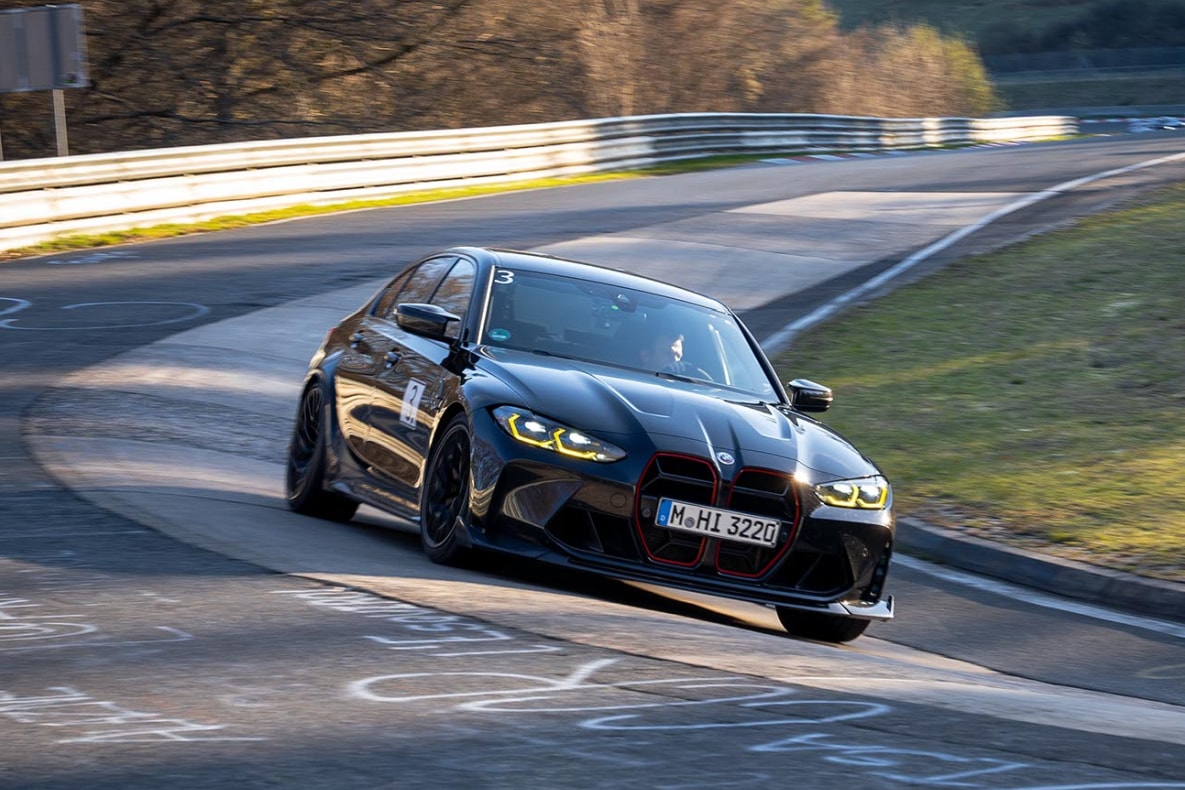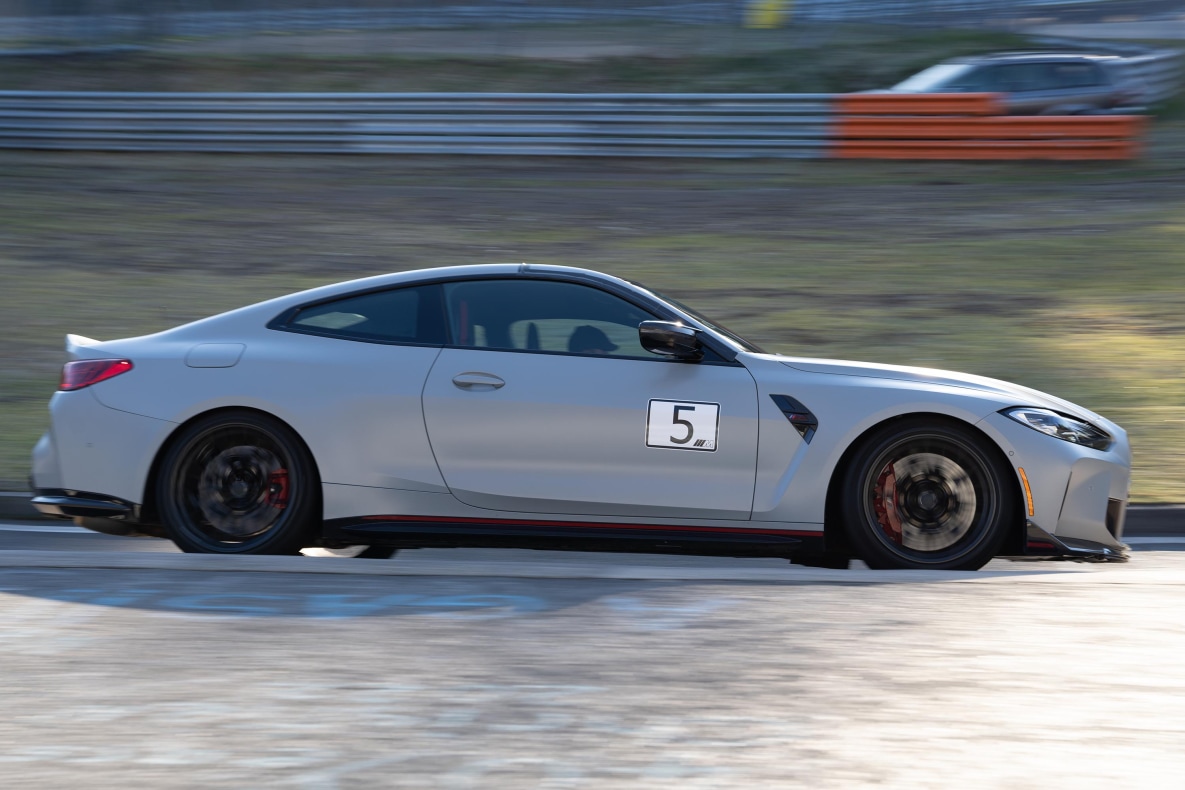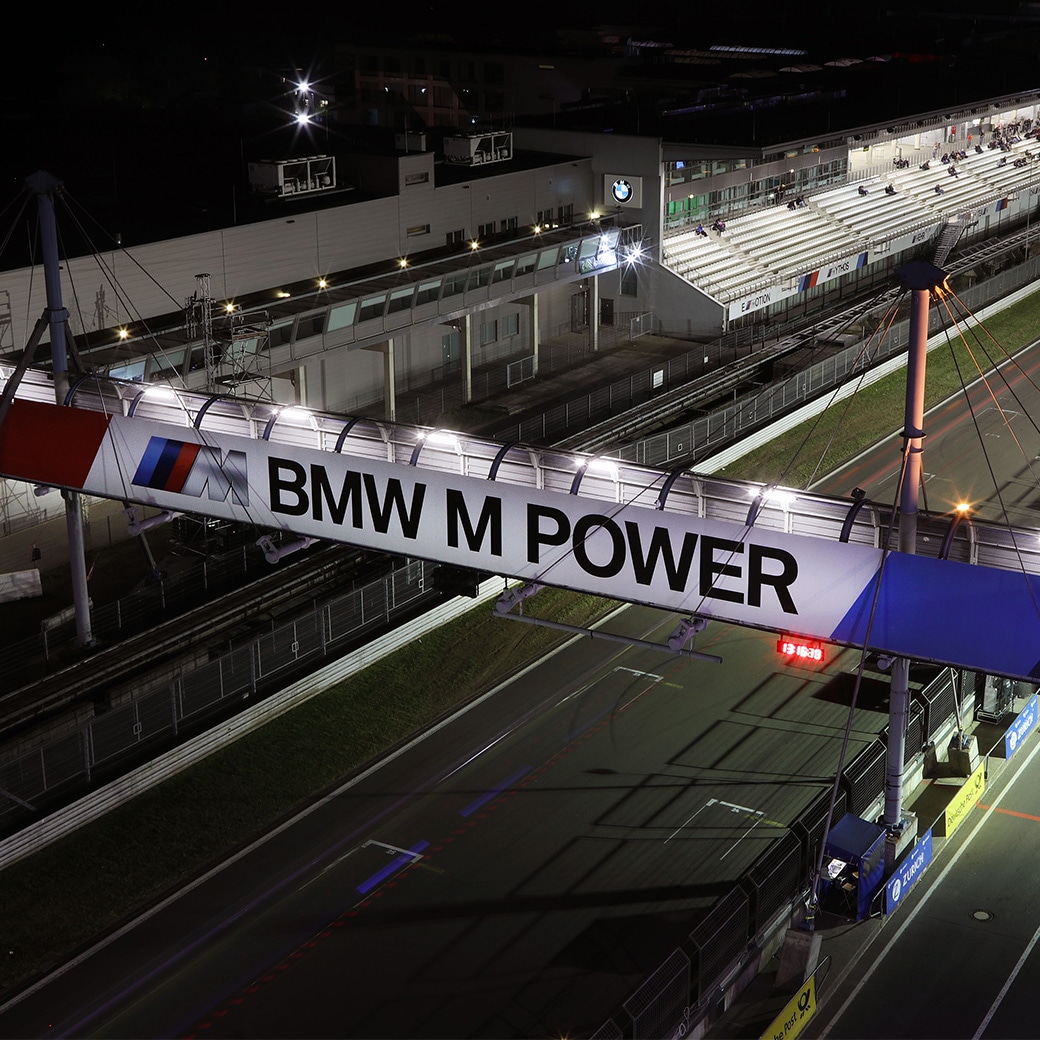The engine’s running, the driver’s behind the wheel. As soon as he gives the sign, the crew are ready to whip the warmers off the tyres, turn the lever rods of the hydraulic jacks in sync to the left and put the BMW M2 back on its wheels so that it can get going. On a flying start on the Nordschleife of the Nürburgring. To go out and break records.
MONTHS OF PREPARATION.
There was a lot of preparation necessary to get to this sunny April day. From booking the Nürburgring to coordinating the vehicles. Another important point is the logistics – a whole heap of stuff had to be transported from Garching near Munich to the Eifel including wheels, tools, tyre-warmers and lots more besides. The first planning meetings were held months ago. Then, about two weeks before the big day it was crunch time when the vehicles took to the Nordschleife – albeit under bad weather conditions. “We had to keep waiting for dry spells and couldn’t complete a single timed lap”, says Jörg Weidinger. The development engineer is responsible for the overall set-up at BMW M. He’s also a practised record driver and will be behind the wheel today.
Apart from Jörg, there are seven other men on the operative team: a four-man crew who prepare tyres and vehicles and three technical directors. They’re responsible for the technical scrutineering of the vehicles and the coordination of the record attempts.
“100% SERIES VEHICLES.”
Today is all about records for series vehicles, something that BMW M takes very seriously: Even though the team could make changes to the vehicles within the regulations, they don’t. “Generally speaking, our credo for record runs is: We use 100% series vehicles that can be bought just as they are now”, says Klaus Huber, head of Driving dynamics and setup at BMW M. If for example a car goes for a record with a carbon roof and bucket seats, these must also be purchasable for this model. The Track tyres are also part of the BMW M original equipment.

Time to go: All four men on the jacks raise an arm – the sign that the BMW M2 has been set down and the jacks are no longer under the vehicle. The record car is headed for the Nordschleife access. Right behind the BMW M2 is a second M automobile. The striking BMW M3 Touring in the extrovert Isle of Man Green Metallic paintjob is a so-called Rescue Vehicle with two fire extinguishers on board. If there was an accident, the driver would be able to help the record attempt car more quickly than the track marshals on foot.

THE PLACE IS BUZZING.
THE PLACE IS BUZZING.
One day before the scheduled record attempt, things really get going. Most vehicles drive to the Eifel under their own steam, just like a real M automobile should: Besides their racetrack capability, they’re also perfectly suited to everyday use and long-distance cruising. Only top-secret models due to be launched shortly come under cover of a trailer. The destination however remains the same: the BMW M Test Centre at the Nürburgring. On record days, the workshop here is the control centre. 24 hours before an attempt the place is buzzing. All the hydraulic lifts are occupied, tool trolleys trundle noisily about, the typical squeal of rubber tyres on concrete floors can be heard everywhere. Final vehicle checks are made.
THE TÜV HAS TO GIVE ITS GO.

THE TÜV HAS TO GIVE ITS GO.
Today, the vehicles are not only being prepared for the record attempt on the Nordschleife – the most important item on the agenda in the Test Centre is the TÜV (Technischer Überwachungsverein; the german equivalent to the MoT) approval. The test engineer examines the vehicles painstakingly. His clearance is the precondition that tomorrow’s record attempt is allowed to take place. And the procedure goes a lot further than a TÜV general inspection. The BMW M models are also weighed, the vehicle identification numbers checked and the various different components like rims, suspension and engine scrutinized. The TÜV technician documents everything and takes photos. Before the record attempt can take place the following day, the inspector checks the cars again briefly and monitors the preparations on the track. It’s a closely-meshed procedure to make sure that only series vehicles take part.

The second official and one of the most important people on a day of record attempts is the notary. Before the start, he confirms the TÜV approval, monitors the timekeeping and is positioned at the tourist entrance to the Nürburgring. This is where the lap times are recorded and verified.
FINAL DISCUSSIONS.
The evening before the record attempt, the whole team meets in the workshop. They form a circle, while two colleagues join them down the line via two laptops on the boot lid. There’s no motivational pep-talk, just the last points that need clearing up along with the final schedule. Now the tension is almost palpable, as the whole record now depends on the one parameter that no-one can influence: the changeable Eifel weather. It has to stay dry.

The perfect matching of suspension, engine, transmission and co is a series component of our vehicles: We achieve records in SPORT mode which was tuned to suit the Nürburgring.
The record-hungry BMW M2 and the Rescue Vehicle drive onto the Döttinger Höhe and disappear out of sight. The sound of the engines dies away. The team has watched both BMW M automobiles go and then immediately begun preparations for the next lap. The crew is now in a white trackside pavilion containing more than a dozen sets of wheels, most covered by tyre warmers. 70° Celsius is the ideal temperature for the tyres for most M models. The crew tear open the Velcro fastenings to warm the next set. In between, the quiet hissing of the air pump can be heard. The tyre pressure has to be perfect to ensure all four wheels have the best possible grip on the track.
RECORDS NEED THE RIGHT FEELING.
The day has begun cold, the temperature was around freezing point. But at 7.30am as the crew starts setting up its base at the Nordschleife approach, the sun comes out. It will however stay a cold 7°C all day long, the lower limit for good lap times on the Nürburgring. “Cool temperatures are basically advantageous”, says Klaus Huber. “They ensure good engine cooling when we’re pushing the envelope. Today, the sun is also warming the asphalt which means it can work well with the tyres.” Towards noon it’s all set: the first vehicle arrives. Until now, it’s been waiting in the warm Test Centre for its cue. Before the first record attempt however the car does a warm-up lap on used prewarmed tyres. “This lap serves to adapt to the vehicle and the track conditions and to get a feel for how the tyres change during the lap in order to define the correct filling pressure”, explains Klaus Huber. Driving record laps still needs experience and feeling.
ONLY THREE RUNS.

ONLY THREE RUNS.
And the dress rehearsal is already a success: Driver Jörg Weidinger senses that he’s beaten the old lap record, but could go one better. As soon as the BMW M automobile is back at the starting point, he jumps out of the car and notes down new tyre pressures. He has three goes for this M model, then all the fresh tyres are used up. Used tyres wouldn’t bring the performance peak needed to make the difference between a fast lap and a record lap. The new tyres are fitted, the tank filled and Jörg Weidinger starts his first attempt at the record.

A brief moment of excitement on the Nordschleife approach: The BMW M2 on course for the record is heading for the long straight between Döttinger Höhe and Tiergarten. The crew swarm to the trackside, some whip out mobile phones to capture the moment. In solemn silence, they watch the record vehicle appear, drowning out the birdsong with its throaty roar. It shoots past and disappears into the rise at Tiergarten. Some distance behind follows the green Rescue Vehicle, now turning into the Nordschleife approach. The last section to the light barrier which ends the timed lap has to be covered by the record vehicle by itself.
We know what the vehicles are capable of. But in the end, you only see on the day of the record attempt whether all the factors fit.
ALL-IN FOR ONE LAP.
Today, record driver Jörg Weidinger faces an additional challenge: He cannot allow his concentration to falter, even after several hours at the wheel. He doesn’t have any tricks or gimmicks: “There’s a kind of flow feeling. That enables me to perform at the max all day long”, he says. This flow feeling is felt by everyone in the team. It’s the secret ingredient for success, because every mistake, be it by the driver, in the preparation of the vehicle or in the coordination, could cost them the record.
COOLING DOWN ON EIFEL ROADS.
After crossing the finishing line, there’s a delay before the cars return to the team at the Nordschleife approach. First, the M automobiles are cooled down on a short drive through the Eifel, a step that is as important as warming up the engine before the record attempt. “After a lap on the limit, above all the engine and the brakes need time to cool down slowly”, explains Klaus Huber. “This happens at lower revs and less demanding braking, along with a cooling airflow. Cooling down is not just a must at record attempts, but after every operation on the racetrack.”

A voice can be heard coming from Klaus Huber’s radio. “He’s finished”, it says. Whether this lap was a record or not, no one yet knows. The crew prepares everything for the next attempt just in case, positioning the jacks. Huber is still on the radio when the BMW M2 turns into the car park before the Nordschleife approach, Weidinger parks the car, but remains in his seat to analyse some data. Then he gets out. “And?” he asks. A small group have formed around him and Klaus Huber. Everyone wants to know the result. Huber states the time, and everyone breaks into a smile, Weidinger even does a little jump. They’ve done it, BMW M has set a new record. But there’s no time to celebrate – the next vehicle is already turning into the car park.

